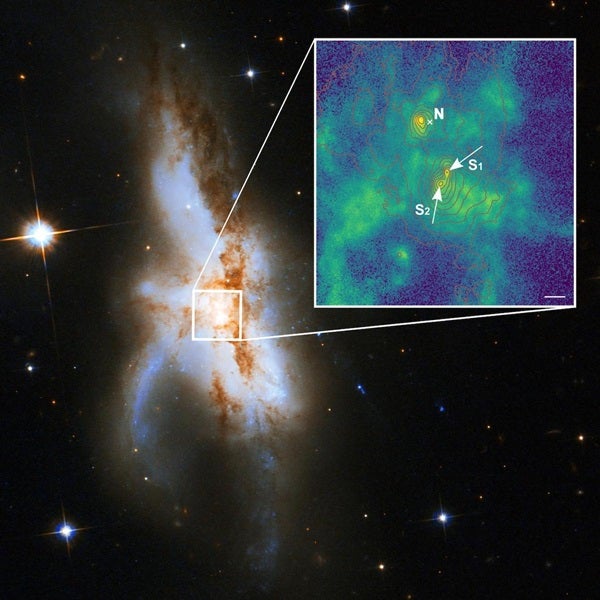Catching two supermassive black holes sharing close quarters isn’t that unusual. But spotting three jockeying for position is quite bizarre. In fact, astronomers rarely witness such a triplet. But now, according to a new study accepted for publication in Astronomy & Astrophysics, astronomers have discovered a single galaxy that’s home to three supermassive black holes: NGC 6240.
Three black holes for the price of one
In the study, an international team of astronomers identified three supermassive black holes lurking near the center of galaxy NGC 6240, which has been visibly disturbed by the gravitational effects of a triple merger. NGC 6240 is relatively close — only about 300 million light-years away — and astronomers previously assumed its odd shape was the result of a run-of-the-mill merger between two galaxies. These two galaxies, they thought, slammed together while moving at hundreds of miles per second, and they’re still in the process of melding together. Therefore, the researchers expected to find two supermassive black holes hiding near the center of the cosmic collision.
Instead, when they peered into NGC 6240’s core using 3D-mapping techniques, the team unexpectedly found three supermassive black holes — each weighing more than 90 million Suns. (For comparison, the supermassive black hole at the center of the Milky Way, Sagittarius A*, weighs about 4 million solar masses.) What’s more, NGC 6240’s three behemoth black holes are all crammed into a region less than 3,000 light-years across, which is less than one percent the size of the galaxy in which they reside.
“Up until now, such a concentration of three supermassive black holes had never been discovered in the universe,” said study co-author Peter Weilbacher of the Leibniz Institute for Astrophysics Potsdam in a press release. Although astronomers have previously found three separate galaxies and their associated black holes on a collision course before, this is the first time they’ve witnessed a trifecta of supermassive black holes crammed into such a small space.
The finding is not only a strange, exciting, and unprecedented discovery, but it also shows how multiple galaxies can come together simultaneously to build the universe’s biggest galaxies. That’s a process that has mystified astronomers, who see galaxies today that are too huge to have been built up by slower, two-galaxy mergers, even despite the universe’s almost 14-billion-year age.
“If, however, simultaneous merging processes of several galaxies took place, then the largest galaxies with their central supermassive black holes were able to evolve much faster,” Weilbacher said. “Our observations provide the first indication of this scenario.”










